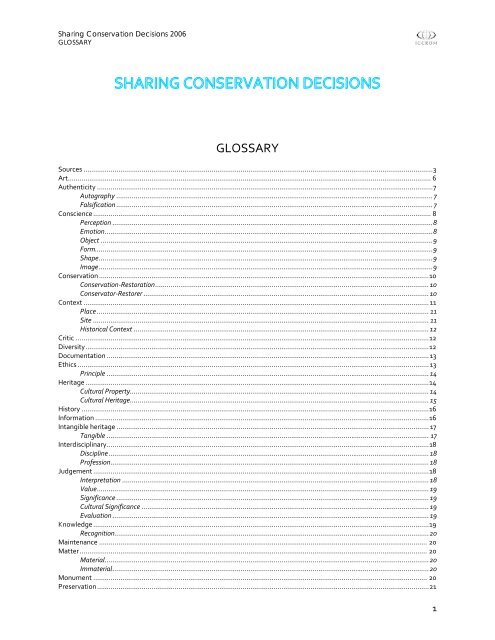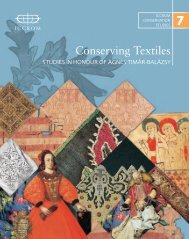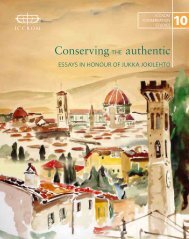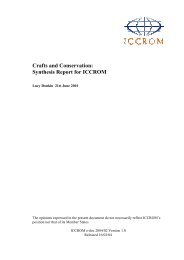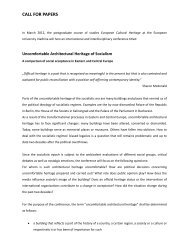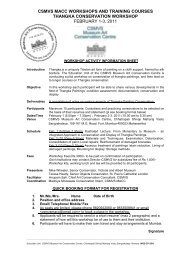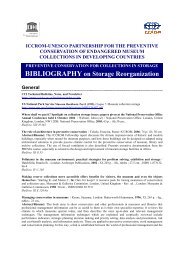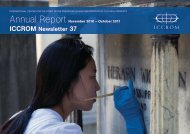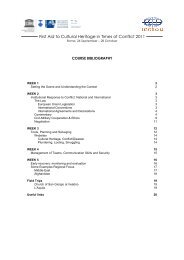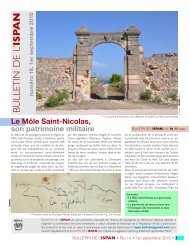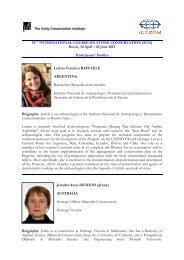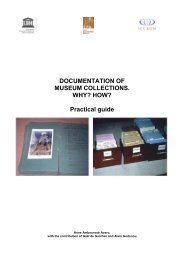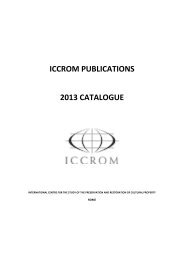English Glossary - Iccrom
English Glossary - Iccrom
English Glossary - Iccrom
Create successful ePaper yourself
Turn your PDF publications into a flip-book with our unique Google optimized e-Paper software.
Sharing Conservation Decisions 2006<br />
GLOSSARY<br />
GLOSSARY<br />
Sources ....................................................................................................................................................................................3<br />
Art........................................................................................................................................................................................... 6<br />
Authenticity .............................................................................................................................................................................7<br />
Autography ...................................................................................................................................................................7<br />
Falsification ...................................................................................................................................................................7<br />
Conscience.............................................................................................................................................................................. 8<br />
Perception .....................................................................................................................................................................8<br />
Emotion.........................................................................................................................................................................8<br />
Object ...........................................................................................................................................................................9<br />
Form..............................................................................................................................................................................9<br />
Shape............................................................................................................................................................................9<br />
Image............................................................................................................................................................................9<br />
Conservation ..........................................................................................................................................................................10<br />
Conservation‐Restoration.............................................................................................................................................10<br />
Conservator‐Restorer ...................................................................................................................................................10<br />
Context ..................................................................................................................................................................................11<br />
Place ........................................................................................................................................................................... 11<br />
Site ............................................................................................................................................................................. 11<br />
Historical Context ........................................................................................................................................................12<br />
Critic ......................................................................................................................................................................................12<br />
Diversity.................................................................................................................................................................................12<br />
Documentation ......................................................................................................................................................................13<br />
Ethics .....................................................................................................................................................................................13<br />
Principle ......................................................................................................................................................................14<br />
Heritage .................................................................................................................................................................................14<br />
Cultural Property..........................................................................................................................................................14<br />
Cultural Heritage.......................................................................................................................................................... 15<br />
History ...................................................................................................................................................................................16<br />
Information ............................................................................................................................................................................16<br />
Intangible heritage ................................................................................................................................................................. 17<br />
Tangible ...................................................................................................................................................................... 17<br />
Interdisciplinary......................................................................................................................................................................18<br />
Discipline.....................................................................................................................................................................18<br />
Profession....................................................................................................................................................................18<br />
Judgement .............................................................................................................................................................................18<br />
Interpretation ..............................................................................................................................................................18<br />
Value...........................................................................................................................................................................19<br />
Significance .................................................................................................................................................................19<br />
Cultural Significance ....................................................................................................................................................19<br />
Evaluation ...................................................................................................................................................................19<br />
Knowledge.............................................................................................................................................................................19<br />
Recognition..................................................................................................................................................................20<br />
Maintenance ......................................................................................................................................................................... 20<br />
Matter................................................................................................................................................................................... 20<br />
Material.......................................................................................................................................................................20<br />
Immaterial...................................................................................................................................................................20<br />
Monument ............................................................................................................................................................................ 20<br />
Preservation...........................................................................................................................................................................21<br />
1
Sharing Conservation Decisions 2006<br />
GLOSSARY<br />
Prevention............................................................................................................................................................................. 22<br />
Research ............................................................................................................................................................................... 22<br />
Analysis.......................................................................................................................................................................22<br />
Investigation................................................................................................................................................................23<br />
Examination ................................................................................................................................................................23<br />
Restoration ............................................................................................................................................................................23<br />
Science.................................................................................................................................................................................. 24<br />
Technique ..............................................................................................................................................................................25<br />
Theory....................................................................................................................................................................................25<br />
Use.........................................................................................................................................................................................25<br />
Accessibility .................................................................................................................................................................26<br />
Participation................................................................................................................................................................26<br />
2
Sharing Conservation Decisions 2006<br />
GLOSSARY<br />
SOURCES<br />
AAT<br />
Art & Architecture Thesaurus on line ‐ The Getty Research institute<br />
http://www.getty.edu/research/conducting_research/vocabularies/aat<br />
AIC<br />
AIC ‐ The American Institute for Conservation of Historic and Artistic Work<br />
http://aic.stanford.edu/geninfo.defin.html<br />
APEL<br />
www.apel.eu.org<br />
Survey of the legal and professional responsibilities of the conservator‐restorers as regard the other parties involved in<br />
the preservation and conservation of cultural heritage, APEL (acteurs du patrimoine européen et législation/ ECCO<br />
(European confederation of conservator‐restorer's organisations) , Roma: Rocografia, 2001 pp. 275‐281<br />
BURRA CHARTER 1999<br />
The Burra Charter 1999 ‐ The Australia ICOMOS charter for places of cultural significance<br />
http://www.getty.edu/conservation/research_resources/charters.html<br />
CHARLESTON 2005<br />
Charleston Declatation 2005, USI/ICOMOS 8 th International symposium<br />
http://www.icomos.org/usicomos/Symposium/SYMP05/Charleston_Declaration.htm<br />
CHINA PRINCIPLES 2001<br />
Principles for the Conservation of Heritage Sites in China 2001, ICOMOS China<br />
www.icomos.org/australia/images/pdf/china_prin.pdf<br />
COMMENTARIES AIC<br />
Commentaries to the Guidelines for Practice of the Aic<br />
http://aic.stanford.edu/pubs/comment20.html<br />
DICTIONARY OF PHILOSOPHY<br />
Dictionary of Philosophy (Ancient ‐ Medieval ‐ Modern) edited by Dagobert D. Runes 1942<br />
Indexed in the Meta‐Encyclopedia of Philosophy www.ditext.com/runes/index.html<br />
ECCO<br />
European Confederation of Conservator‐Restorers' Organizations<br />
www.ecco‐eu.info<br />
ENCYCLOPAEDIA BRITANNICA<br />
Hazel Watson & Viney Limited, London 1961<br />
ENCYCLOPEDIA OF WORLD ART<br />
Mc Graw Hill Publishing Company Limited, London<br />
1959‐1966<br />
HAGUE 1954<br />
Convention for the Protection of Cultural Property in the Event of Armed Conflict 1954, UNESCO<br />
http://www.icomos.org/hague/hague.convention.html<br />
HEREIN<br />
HEREIN Thesaurus European Heritage Network<br />
3
Sharing Conservation Decisions 2006<br />
GLOSSARY<br />
http://www.european‐heritage.net/sdx/herein/thesaurus/consult.xsp<br />
HISTORIC GARDENS 1981<br />
Historic Gardens, the Florence Charter 1982, ICOMOS<br />
www.international.icomos.org/charters/gardens_e.htm<br />
ICOM CODE OF ETHICS<br />
ICOM Code of Ethics for Museums, 2006<br />
http://icom.museum/ethics.html<br />
ICOMOS INTERPRETATION 2007<br />
Icomos ENAME Charter for the interpretation of cultural heritage sites<br />
www.icomos.org/usicomos/Symposium/Ename_Charter<br />
ILLICIT 1970<br />
Convention on the Means of Prohibiting and Preventing the Illicit Import, Export and Transfer of Ownership of<br />
Cultural Property, UNESCO<br />
www.unesco.org/culture/laws/1970/html_eng/page1.shtml<br />
INTANGIBLE2003<br />
Convention for the Safeguarding of the Intangible Cultural Heritage, UNESCO 2003<br />
http://www.getty.edu/conservation/research_resources/charters.html<br />
INTERNET ENCYCLOPEDIA OF PHILOSOPHY<br />
www.iep.utm.edu<br />
ITALIAN NORMS 1932<br />
Carta Italiana del Restauro 1932, Consiglio Superiore per le antichità e belle arti, Norme per il restauro dei<br />
monumenti (Giovannoni, Gustavo, Bollettino d'Arte, January 1932)<br />
www.nardinirestauro.it/download/pdf/carte/Carta_restauro%20_1932.pdf<br />
NARA DOCUMENT 1994<br />
Nara Document on Authenticity, UNESCO 1994<br />
http://www.getty.edu/conservation/research_resources/charters.html<br />
NEW ENCYCLOPAEDIA BRITANNICA<br />
The New Encyclopaedia Britannica, 15th edition ‐ 1975<br />
OXFORD<br />
‐ The New Oxford dictionary of <strong>English</strong>, Clarendon Press, Oxford 1998<br />
‐ Compact Oxford <strong>English</strong> Dictionary www.askoxford.com<br />
PARMA 2003<br />
CHARTER OF PARMA, National Representatives Group for digitization, European Conference of MINERVA 2003<br />
www.minervaeurope.org/structure/nrg/documents/charterparma.htm<br />
PLACES 1992<br />
Charter for the Conservation of Places of Cultural Heritage Value, ICOMOS New Zealand 1992<br />
www.icomos.org/docs/nz_92charter.html<br />
RESTORATION 1972<br />
Carta Italiana del Restauro 1972<br />
www.nardinirestauro.it/download/pdf/carte/Carta_restauro%20_1972.pdf<br />
4
Sharing Conservation Decisions 2006<br />
GLOSSARY<br />
STANFORD ENCYCLOPEDIA<br />
www.plato.stanford.edu/entries/kant‐judgment/#1<br />
UNESCO DIVERSITY2001<br />
UNESCO Universal Declaration for Cultural Diversity, UNESCO 2001<br />
http://portal.unesco.org/culture<br />
UNESCO PROTECTION 1972<br />
Convention Concerning the Protection of the World Cultural and Natural Heritage, UNESCO 1972<br />
http://whc.unesco.org/en/conventiontext/<br />
UNESCO WHC<br />
UNESCO world Heritage List<br />
http://whc.unesco.org/en/about/<br />
VENICE CHARTER 1964<br />
The Venice Charter 1964 ‐ International charter for the conservation and restoration of monuments and sites<br />
http://www.getty.edu/conservation/research_resources/charters.html<br />
5
Sharing Conservation Decisions 2006<br />
GLOSSARY<br />
ART<br />
(Greek techne; Latin ars, art)<br />
ENCYCLOPEDIA OF WORLD ART<br />
Throughout history, artistic phenomena have been distinguished as products of human will and action from<br />
natural events. Not all objects produced by man have artistic value, nor are there any classes of objects which can<br />
be considered artistic as a whole; on the other hand no categories can be considered entirely inartistic. Even the<br />
distinction between objects of an instrumental nature and object which are artistically valid per se does not<br />
represent a distinction between artistic and non artistic objects, since even a tool or a machine can achieve artistic<br />
value as a finished object. The fact that certain objects or classes of objects have been produced with the specific<br />
and exclusive purpose of achieving artistic value has been offered as a criterion by which to distinguish between<br />
artistic and non artistic categories. From these premises are derived some general conclusions: 1) although every<br />
artistic object is the product of a technical process, technical mastery is not sufficient to guarantee the artistic<br />
value of the result. 2) Even with a definite artistic intention and correct technique, the artistry of the result is still<br />
uncertain; hence the tendency to view it as determined by imponderable factors or by factors which escape the<br />
normal modes of behavior control (fantasy, ecstasy, dream…) and which affect the creative process by diverting it<br />
from accepted techniques. 3) Artistic value can be estimated only in the finished work and through a personal<br />
judgment. Thus it can be stated that artistic value exists, in the practical sense, only in the aesthetic judgment<br />
which recognizes it.<br />
NEW ENCYCLOPAEDIA BRITANNICA<br />
(ART, PHILOSOPHY OF)According to the simplest and widest definition, art is anything that is man‐made.<br />
Within the scope of this definition, not only paintings and sculptures, but also buildings, furniture, automobiles,<br />
cities and garbage dumps are all works of art: every change that human activity has wrought upon the face of<br />
nature is art. In daily life when works of art are spoken of, the intention is to denote a much narrower range of<br />
objects, namely, those responded to aesthetically. Among the things in this narrower range, a distinction,<br />
although not a precise one, is made between fine and useful art. Fine art consists of those works designed to<br />
produce an aesthetic response or that (regardless of design) function as objects of aesthetic appreciation (such as<br />
paintings, sculptures, poems...).<br />
The aesthetic sense of world art whether applied to fine art or useful art, is the one most employed by the<br />
majority of critics and philosophers of art today. There are two other senses of art, however, that are still<br />
narrower, and to avoid confusion, they use should be noted: 1) sometimes the term art is restricted to the visual<br />
arts alone. But as philosophers of art uses the term, art is not limited to visual arts; music and drama and poetry<br />
are as much arts as painting, sculpture and architecture; 2) sometimes the term art is used in a persuasive sense,<br />
to include only those works considered good art.<br />
The word art is also ambiguous in other way: it is sometimes used to designate the activity to creating a work of<br />
art; but is much often used to designate the product of that process, the completed artwork or artifact itself. All<br />
that seems to be required for identifying something as a work of art in the narrower sense is that it functions<br />
aesthetically in man’s experience, either wholly (fine arts) or in part (useful art); it is not even necessary that it be<br />
intended by its creator to function in this way.<br />
(ARTS, CLASSIFICATION OF THE) <strong>English</strong> term art and its equivalents in Greek and Latin covered not only what<br />
are now called fine arts, or aesthetic arts, but any kind of transmitted, useful skill, such as agriculture, medicine<br />
and war. In the 18 th century the so called beaux arts, the beautiful or fine arts, were distinguished from the merely<br />
useful arts on the ground that they were aimed at giving aesthetic pleasure to the beholder. In the 19 th and 20 th<br />
centuries, there has been a tendency to abandon the term art in speaking of the purely utilitarian skills and to call<br />
them instead industries, technics, applied sciences. Without the prefix fine, the word art alone is now commonly<br />
understood to mean the fine or aesthetic arts. In psychology, anthropology and other sciences, a particular<br />
product or performance does not have to be beautiful or aesthetically satisfying to qualify as art: they may be<br />
classed as art if they belong to types of product or performance that have been socially recognized as having an<br />
aesthetic function. In this sense any picture, clay figure, dance or traditional song can be accepted as work of art,<br />
whether beautiful or not. Being non‐valutative, this conception makes it possible for scientist to study the arts as<br />
a field of cultural phenomena for investigation, without having to show in advance that they are pleasant, good or<br />
beautiful.<br />
6
Sharing Conservation Decisions 2006<br />
GLOSSARY<br />
In another sense of art, called the expressionist theory, art has been defined as the expression and transmission of<br />
remembered emotion, and in a third sense, an extremely narrow one the concept of art is limited to visual arts<br />
alone.<br />
DICTIONARY OF PHILOSOPHY<br />
In Aristotle the science or knowledge of the principles involved in the production of beautiful or useful objects. As<br />
a branch of knowledge art is distinguished both from theoretical science and from practical wisdom; as a process<br />
of production it is contrasted with nature.<br />
In its narrower meaning, the fine arts and literature. The problem of the distinction and classification of the arts<br />
originated with Lessing in reaction to the interference of poetical values in painting and vice versa. He<br />
distinguished poetry dealing with consecutive actions from painting concerned with figures coexisting in space.<br />
Later, aestheticians divided the arts into many classifications. Zimmermann, a pupil of Herbart, distinguished<br />
three groups:<br />
• arts of material representation (architecture, sculpture, etc.),<br />
• arts of perceptive representation (painting, music).<br />
• arts of the representation of thought (poetry).<br />
AAT<br />
Refers to objects, environments, or experiences (as in performance art) that are visual in nature, were created by<br />
the use of skill and imagination, and possess an aesthetic that is valued and of a quality and type that would be<br />
collected by art museums. It may refer to the study or practice of the fine arts or the fine and decorative arts<br />
together. With reference to the visual and performing arts together, use "arts." The meaning may overlap with<br />
"works of art" or "art objects."<br />
AUTHENTICITY<br />
(Greek authentikos; Latin authenticus)<br />
NARA DOCUMENT<br />
10. …The understanding of authenticity plays a fundamental role in all scientific studies of the cultural heritage, in<br />
conservation and restoration planning, as well as within the inscription procedures used for the World Heritage<br />
Convention and other cultural heritage inventories.<br />
11. All judgements about values attributed to cultural properties as well as the credibility of related information<br />
sources may differ from culture to culture, and even within the same culture. It is thus not possible to base<br />
judgements of values and authenticity within fixed criteria. On the contrary, the respect due to all cultures<br />
requires that heritage properties must considered and judged within the cultural contexts to which they belong.<br />
12. Therefore, it is of the highest importance and urgency that, within each culture, recognition be accorded to<br />
the specific nature of its heritage values and the credibility and truthfulness of related information sources.<br />
13. Depending on the nature of the cultural heritage, its cultural context, and its evolution through time,<br />
authenticity judgements may be linked to the worth of a great variety of sources of information. Aspects of the<br />
sources may include form and design, materials and substance, use and function, traditions and techniques,<br />
location and setting, and spirit and feeling, and other internal and external factors. The use of these sources<br />
permits elaboration of the specific artistic, historic, social, and scientific dimensions of the cultural heritage being<br />
examined.<br />
Autography<br />
(Latin autographum, from greek autographon, autographos ‘written with one’s own hand’, from autos ‘self’ and<br />
graphos ‘written’)<br />
ENCYCLOPAEDIA BRITANNICA<br />
An autograph is any manuscript written by its author.<br />
Falsification<br />
(Latin Falsificus, making false, from falsus)<br />
7
Sharing Conservation Decisions 2006<br />
GLOSSARY<br />
ENCYCLOPEDIA OF WORLD ART<br />
(Falsification)True forgery is the deliberate manufacture of a spurious object with intent to deceive. Falsification,<br />
a broader term, includes, in addition to forgery, the misrepresentation as “the real thing” of a copy or imitation<br />
not originally produced for deceptives purposes.<br />
Falseness is a subjective human value; it exists only when it is intended an perceived as such; it does not inhere the<br />
object itself…falsity is not a property of the object in question but is an aspect of judgment concerning the<br />
relation of the object to the idea and intention of its creation and distribution. A relative judjment is required in<br />
deciding what is false.<br />
CONSCIENCE<br />
(Latin conscientia, conscient – being privy to, from the verb conscire, from con – with, scire ‐ know)<br />
INTERNET ENCYCLOPEDIA OF PHILOSOPHY<br />
The abstract noun “consciousness” is not often used in the contemporary literature, though it should be noted<br />
that it is originally derived from the Latin con (with) and scire (to know). Thus, “consciousness” has etymological<br />
ties to one’s ability to know and perceive, and should not be confused with conscience, which has the much more<br />
specific moral connotation of knowing when one has done or is doing something wrong. Through consciousness,<br />
one can have knowledge of the external world or one’s own mental states. It might seem that “conscious” is<br />
synonymous with, say, “awareness” or “experience” or “attention.” However, it is crucial to recognize that this is<br />
not generally accepted today. For example, though perhaps somewhat atypical, one might hold that there are<br />
even unconscious experiences, depending of course on how the term “experience” is defined. More common is<br />
the belief that we can be aware of external objects in some unconscious sense, for example, during cases of<br />
subliminal perception. The expression “conscious awareness” does not therefore seem to be redundant. Finally, it<br />
is not clear that consciousness ought to be restricted to attention. It seems plausible to suppose that one is<br />
conscious (in some sense) of objects in one’s peripheral visual field even though one is only attending to some<br />
narrow (focal) set of objects within that visual field.<br />
Perception<br />
(Latin percipere ‘seize, understand’; from per‐ ‘entirely’ + capere ‘take’)<br />
AAT<br />
The process of becoming aware of objects, qualities, or relations via the sense organs; involves the reception,<br />
processing, and interpretation of sensory impressions.<br />
NEW ENCYCLOPAEDIA BRITANNICA<br />
Perception, or perceiving, refers to the process whereby sensory stimulation is translated into organized<br />
experience. That experience, or percept, is the joint product of the stimulation and of the process itself. Because<br />
the perceptional process is not itself public or directly observable, the validity of perceptual theories can be<br />
checked only indirectly. Historically, systematic thought about perceiving was the province of philosophy. Indeed<br />
perceiving remains of interest to philosophers, and many issues about the process that were original raised by<br />
philosophers, are still of current concern. As a scientific enterprise, however, the investigation of perception has<br />
especially developed as a part of the larger discipline of psychology. Philosophical interest in perceptions stems<br />
largely from questions about the sources and the validity of what is called human knowledge.<br />
Emotion<br />
(Latin emovere, e‐ out, movere move)<br />
ENCICLOPEDIA OF WORLD ART<br />
(Psychology of art) According to Baensch (1923‐24) the function of art is “to raise the emotional content of the<br />
world to the level of an objectively valid cognition”, in other words to create concrete and sensuously<br />
apprehensible symbols for any kind of feeling.<br />
8
Sharing Conservation Decisions 2006<br />
GLOSSARY<br />
AAT<br />
Refers to a complex phenomena and quality of consciousness, featuring the synthesis or combination of<br />
subjective experiences and perceptions, expressive physiological and psychological behaviors, and the excitation<br />
or stimulation of the nervous system. Among psychological studies, the concept is associated with ideas on<br />
personality formation, rational and irrational thinking, and cognitive motivation.<br />
Object<br />
(Lat. Objectum ‘things presented to the mind’, neuter past participle of obicere, from ob‐ ‘in the way of’ + jacere ‘to<br />
throw’)<br />
OXFORD<br />
A material thing that can be seen and touched. (Philosophy) A thing external to the thinking mind or subject.<br />
DICTIONARY OF PHILOSOPHY<br />
In the widest sense, object is that towards which consciousness is directed. The cognitive or epistemological<br />
object of mind is anything perceived, imagined, conceived or thought about.<br />
Form<br />
(Greek eidos, Latin forma)<br />
DICTIONARY OF PHILOSOPHY<br />
The intelligible structure, characters constituting a substance or species of substances, as distinguished from the<br />
matter in which these characters are embodied; essence; formal cause.<br />
In Art: opposite of content. The conclusive aspect of art, the surpassing of emotions, taste, matter, the final<br />
imprint of the personality of the artist; and opposite of color. The plastic form achieved by drawing and<br />
chiaroscuro.<br />
AAT<br />
Use with reference to works of art and architecture to mean the arrangement of visual elements such as line,<br />
mass, shape, or color.<br />
Shape<br />
(Old <strong>English</strong> gesceap ‘external form, also creation’, sceppan ‘create’ of Germanic origin)<br />
OXFORD<br />
The external form or appearance characteristic of something or somehone; the outline of an area or a figure, the<br />
distinctive nature or quality of someone or something.<br />
AAT<br />
The outline, form, or characteristic configuration of an object, including its contours; the external form or outer<br />
boundary of the object.<br />
Image<br />
(Latin imago, likeness, related to imitate)<br />
DICTIONARY OF PHILOSOPHY<br />
A sensory quality reinstated by the mind in the absence of sensory stimulation.<br />
OXFORD<br />
A mental representation or idea, a simile or metaphor, an idol in biblical use.<br />
AAT<br />
9
Sharing Conservation Decisions 2006<br />
GLOSSARY<br />
In a general sense, refers to depictions, representations, or other optical counterparts of the external form of an<br />
object, person, animal, place, or phenomenon. In a narrow sense, it refers to such a depiction as opposed to a<br />
larger context, such as in distinguishing an image from its support (e.g., when referrring to a drawing).<br />
CONSERVATION<br />
(Latin conservare to preserve, from con‐ together and servare to keep)<br />
VENICE CHARTER 1964<br />
The conservation of a monument implies preserving a setting which is not out of scale. Wherever the traditional<br />
setting exists, it must be kept. No new construction, demolition or modification which would alter the relations of<br />
mass and colour must be allowed.<br />
BURRA CHARTER 1999<br />
Conservation is an integral part of the management of places of cultural significance and is an ongoing<br />
responsibility…Conservation means all the processes of looking after a place so as to retain its cultural<br />
significance.<br />
CHINA PRINCIPLES 2001<br />
Art 2 …Conservation refers to all measures carried out to preserve the physical remains of sites and their historic<br />
settings. The aim of conservation is to preserve authenticity of all the elements of the entire heritage site and to<br />
retain for the future its historic information and all its values. Conservation in practice involves treatment of<br />
damage caused by natural processes and human actions of prevention of further deterioration, using both<br />
technical and management measures. All conservation measure must observe the principle of not altering the<br />
historic condition.<br />
AIC<br />
The profession devoted to the preservation of cultural property for the future. Conservation activities include<br />
examination, documentation, treatment, and preventive care, supported by research and education.<br />
ECCO<br />
Consists mainly of direct action carried out on cultural heritage with the aim of stabilizing condition and retarding<br />
further deterioration.<br />
AAT<br />
Refers to the discipline involving treatment, preventive care, and research directed toward the long‐term<br />
safekeeping of cultural and natural heritage. For actions taken to prevent further changes or deterioration in<br />
objects, sites, or structures, see "preservation," and for changes made to an object or structure so that it will<br />
closely approximate its state at a specific past time, see "restoration (process)."<br />
Conservation‐Restoration<br />
Conservator‐Restorer<br />
APEL<br />
Any action, weather direct or indirect, on an object or a monument, performed in order to safeguard its material<br />
integrity and to guarantee respect for its cultural, historical, aesthetic or artistic significance. This definition<br />
conditions the nature, extent and limitations of the measures that can be adopted, as well as the interventions<br />
that may be made on cultural heritage.<br />
AIC ‐ Conservator<br />
10
Sharing Conservation Decisions 2006<br />
GLOSSARY<br />
A professional, whose primary occupation is the practice of conservation and who, through specialized education,<br />
knowledge, training, and experience, formulates and implements all the activities of conservation in accordance<br />
with an ethical code such as the AIC Code of Ethics and Guidelines for Practice.<br />
ICOM CODE OF ETHICS ‐ Conservator‐Restorer<br />
2.1 The activity of the conservator‐restorer consists of technical examination, preservation, and conservation<br />
restoration of cultural property… Conservator‐Restorer work in museums, in official heritage protection services,<br />
in private conservation enterprises or independently. Their task is to comprehend the material aspect of objects of<br />
historic and artistic significance in order to prevent their decay, and to enhance our understanding of them so as<br />
further the distinction between what is original and what is spurious. The conservator‐restorer’s professional<br />
activities are distinct from those of the artistic or craft profession. A basic criterion of this distinction is that they<br />
do not create new cultural objects.<br />
ECCO ‐ Conservator‐Restorer<br />
A professional who has the training, knowledge, skills, experience and understanding to act with the aim of<br />
preserving cultural heritage for the future, and according to the considerations outlined below. The fundamental<br />
role of the Conservator‐Restorer is the preservation of cultural heritage for the benefit of present and future<br />
generations. The Conservator‐Restorer undertakes responsibility for, and carries out strategic planning;<br />
diagnostic examination; the drawing up of conservation plans and treatment proposals; preventive conservation;<br />
conservation‐restoration treatments and documentation of observations and any interventions.<br />
CONTEXT<br />
(Latin contextus, from texere, to weave).<br />
VENICE CHARTER 1964<br />
ARTICLE 6. The conservation of a monument implies preserving a setting which is not out of scale. Wherever the<br />
traditional setting exists, it must be kept. No new construction, demolition or modification which would alter the<br />
relations of mass and color must be allowed.<br />
ARTICLE 7. A monument is inseparable from the history to which it bears witness and from the setting in which it<br />
occurs. The moving of all or part of a monument cannot be allowed except where the safeguarding of that<br />
monument demands it or where it is justified by national or international interest of paramount importance.<br />
BURRA CHARTER 1999<br />
9.1 The physical location of a place is part of its cultural significance. A building, work or other component of a<br />
place should remain in its historical location. Relocation is generally unacceptable unless this is the sole practical<br />
means of ensuring its survival.<br />
Place<br />
PLACES 1992<br />
Place means any land, including land covered by water and the airspace forming the spatial context to such land,<br />
ancluding any landscape, traditional site or sacred place, and anything fixed to the land including any<br />
archaeological site, garden, building or structure, and any body of water wether fresh or seawater, that forms part<br />
of the historical and cultural heritage (of New Zealand)<br />
UNESCO WHC<br />
Sites: work of man or the combined work of nature and man, and areas including archaeological sites which are of<br />
outstanding universal value from the historical aesthetic ethnological or anthropological point of view.<br />
Site<br />
11
Sharing Conservation Decisions 2006<br />
GLOSSARY<br />
ICOMOS INTERPRETATION 2007<br />
Cultural heritage site refers to a place, locality, natural landscape, settlement area, architectural complex,<br />
archaeological site, or standing structure that is recognized and often legally protected as a place of cultural and<br />
historical significance.<br />
Historical Context<br />
RESTORATION 1972<br />
For the purpose of the identification of the historic centres it is necessary not to consider only the urban ‘centres’<br />
in their traditional senses, but more generally all human settlements which as a whole or in fragments, even<br />
though partly transformed in time, have been established in the past or which, in subsequent periods, have<br />
acquired particular values as a historic testimony or marked urban or architectural qualities. The historic character<br />
refers to the interest that such settlements represents as testimonies of past civilities and as document of urban<br />
culture, even independently from the intrinsic artistic or formal merit or their particular environmental aspect,<br />
which can further enrich or enhance its value, considering that not only architecture, but also the urban fabric in<br />
itself, has significance and value.<br />
CRITIC<br />
(Latin criticus, from Greek kritikos, krites a judge, from krinein judge, decide)<br />
ENCYCLOPEDIA OF WORLD ART<br />
(Art Criticism)Art criticism is the process leading to as qualitative judgment on works of art and the product of<br />
that process. Like literally, musical, and other kind of criticism is distinct from aesthetics as such in that its<br />
purpose is to judge single works or groups of works, while aesthetics is directed toward the evaluation of art in<br />
general, dwelling on individual works and on the artist’s personality only in so far as they as they represent<br />
appropriate applications for the theory aesthetics tries to formulate as a whole. The qualitative judgment of which<br />
art criticism consists take form either in words or as a behavior, in the sense of individual or collective, private or<br />
public action with regard to one, some, or all of the works of an artist or a related groups of artists or the artistic<br />
heritage of a given historical period. We can see criticism as a behavior in public and private collecting, in the<br />
patronage of artists, in art dealing, and in the preservation and restoration of works of art. Criticism as a behavior<br />
may be shown, at its extremes, by an idolatrous cult of certain works of art and the voluntary or careless<br />
destruction of others. We can say that the manifold and varied aspects of artistic experience are given order by art<br />
criticism, by means of the constant forms in which it takes shape. The measure of a work of art is given by its<br />
capacity to survive antithetical or opposing criticism, each of which throws light on some aspect, unnoticed and<br />
unperceived in other critical attitude. The validity of a certain type of criticism must always be assessed by its<br />
capacity to embrace, without surrender its own point of view and its own premises, as much art as is possible.<br />
NEW ENCYCLOPAEDIA BRITANNICA<br />
It may be safely said that criticism in all the arts is concerned with the description and assessment of particular<br />
works. Although some hold that critic’s proper function is only the appraisal or evaluation of works of art, it is<br />
certain that nothing can be evaluated unless it is describable beforehand. It may also be said that all critics of the<br />
arts are concerned with the description and evaluation of works of art as works of art, even they are more<br />
interested in moral, political, religious or ideological or other consideration. It is in this sense that criticism of art is<br />
primarily aesthetic. The criticism of works of art may be considered, at least minimally, as aesthetic criticism, that<br />
is centered on the actual properties of the work considered. Correspondingly, appreciation of art may be said to<br />
be aesthetic when the art is savored or enjoyed in terms of the properties that may be discriminated in it.<br />
Appreciation, in this sense of term, may be informed by criticism, since both are focused on the same properties.<br />
NARA DOCUMENT<br />
DIVERSITY<br />
(Latin diversitas, diversus, past participle of divertere, turn aside)<br />
12
Sharing Conservation Decisions 2006<br />
GLOSSARY<br />
5. The diversity of cultures and heritage in our world is an irreplaceable source of spiritual and intellectual richness<br />
for all humankind. The protection and enhancement of cultural and heritage diversity in our world should be<br />
actively promoted as an essential part of human development.<br />
6. Cultural heritage diversity exists in time and space, and demands respect for other cultures and all aspects of<br />
their belief systems. In cases where cultural values appear to be in conflict, respect for cultural diversity demands<br />
acknowledgment of the legitimacy of the cultural values of all parties.<br />
8…the cultural heritage of each is the cultural heritage of all.<br />
UNESCO DIVERSITY 2001<br />
Art. 1 Culture takes diverse forms across time and space. This diversity embodied in the uniqueness and plurality<br />
of the groups and societies making up humankind. As a source of exchange, innovation and creativity, cultural<br />
diversity is as necessary for humankind as biodiversity is for nature. In this sense, it is the common heritage of<br />
humanity and should be recognized and affirmed for the benefit of present and future generations.<br />
DOCUMENTATION<br />
(Latin documentum lesson, from docere, teach)<br />
AAT<br />
(Document)<br />
Refers especially to recorded information regardless of medium or characteristics, whether created specifically as<br />
records of information or used as such at some time subsequent to their creation. In its broadest sense, however,<br />
can include any item amenable to cataloging and indexing, that is, not only written and printed materials in paper<br />
or microform versions but also nonprint media and, in some circumstances, three‐dimensional objects or realia.<br />
AAT<br />
(Documentation)<br />
Use broadly for the gathering and recording of information, especially to establish or provide evidence of facts or<br />
testimony. For the organizing and controlling of information, use "information management." For the records of<br />
information, regardless of medium or characteristics, either created specifically as records of information or used<br />
as such at some time subsequent to their creation, use "documents."<br />
AIC<br />
Documentation is an invaluable part of the history of cultural property and should be produced and maintained in<br />
as permanent manner as practicable…Documentation is also an important part of the profession’s body of<br />
knowledge. The conservation professional should strive to preserve these records and give other professionals<br />
appropriate access to them.<br />
ECCO<br />
Consists of the accurate pictorial and written record of all procedures carried out, and the rationale behind them.<br />
A copy of the report must be submitted to the owner or custodian of the cultural heritage and must remain<br />
accessible. Any further requirements for the storage, maintenance, display or access to the cultural property<br />
should be specified in this document.<br />
ETHICS<br />
(Lat. ethice, from Greek hē ēthikē (tekhnē) the science of morals, based on ēthos, nature, disposition)<br />
INTERNET ENCYCLOPEDIA OF PHILOSOPHY<br />
The field of ethics, also called moral philosophy, involves systematizing, defending, and recommending concepts<br />
of right and wrong behavior. Philosophers today usually divide ethical theories into three general subject areas:<br />
metaethics, normative ethics, and applied ethics. Metaethics investigates where our ethical principles come from,<br />
and what they mean. Are they merely social inventions? Do they involve more than expressions of our individual<br />
emotions? Metaethical answers to these questions focus on the issues of universal truths, the will of God, the role<br />
13
Sharing Conservation Decisions 2006<br />
GLOSSARY<br />
of reason in ethical judgments, and the meaning of ethical terms themselves. Normative ethics takes on a more<br />
practical task, which is to arrive at moral standards that regulate right and wrong conduct. This may involve<br />
articulating the good habits that we should acquire, the duties that we should follow, or the consequences of our<br />
behavior on others. Finally, applied ethics involves examining specific controversial issues, such as abortion,<br />
infanticide, animal rights, environmental concerns, homosexuality, capital punishment, or nuclear war. By using<br />
the conceptual tools of metaethics and normative ethics, discussions in applied ethics try to resolve these<br />
controversial issues. The lines of distinction between metaethics, normative ethics, and applied ethics are often<br />
blurry.<br />
AAT<br />
System of moral principles or rules of conduct for voluntary human action. For the branch of philosophy that<br />
studies these principles and rules, with respect to the rightness or wrongness of certain human actions, and the<br />
goodness or badness of the motives and ends of such actions, use "ethics (philosophy)."<br />
ethics (philosophy) Use for the branch of philosophy dealing with values relating to human conduct, with respect<br />
to the rightness and wrongness of certain actions, and to the goodness and badness of the motives and ends of<br />
such actions.<br />
Principle<br />
(Latin principium ‘source’, from princeps ‘first, chief’)<br />
OXFORD<br />
1 a fundamental truth or proposition serving as the foundation for belief or action. 2 a rule or belief governing<br />
one’s personal behaviour. 3 morally correct behaviour and attitudes.<br />
HERITAGE<br />
(Latin heres, hered ‐ heir)<br />
OXFORD<br />
Valued objects and qualities such as historic buildings, unspoilt countryside, and cultural traditions that have been<br />
passed down from previous generations; denoting or relating to things of special architectural, historical, or<br />
natural value that are protected and preserved for the nation.<br />
HEREIN<br />
All property inherited from the past, the common inheritance.<br />
Cultural Property<br />
HAGUE 1954<br />
The term “cultural property” shall cover, irrespective of origin and ownership:<br />
• movable or immovable property of great importance to the cultural heritage of every people, such as<br />
monuments of architecture, art or history, whether religious or secular; archeological sites; groups of<br />
buildings which, as a whole, are of historical or artistic interest; works of art; manuscripts, books and<br />
other objects of artistic, historical and archeological interest; as well as scientific collections and<br />
important collections of books or archives or reproductions of the property define above;<br />
• buildings whose main and effective purpose is to preserve, to exhibit the movable cultural property such<br />
as museums, large libraries and depositories of archives… and centers containing a large amount of<br />
cultural property.<br />
ILLICIT 1970<br />
The term “cultural property” means property which, on religious or secular grounds, is specifically designated by<br />
each State as being of importance for archaeology, prehistory, history, literature, art or science and which<br />
belongs to the following cathegories:<br />
14
Sharing Conservation Decisions 2006<br />
GLOSSARY<br />
• rare collections and specimens of fauna, flora, minerals and anathomy and objects of paleontological<br />
interests;<br />
• property relating to history, including the history of science and technology and military and social<br />
history, to the life of national leaders, thinkers, scientist and artist and to the event of natural<br />
importance;<br />
• elements of artistic or historical monuments or archaeological sites which have been dismembered;<br />
• antiquities more than one hundred years old, such as inscriptions, coins and engraved seals;<br />
• object of ethnological interest;<br />
• property of artistic interest, such as<br />
o pictures, paintings and drawings produced entirely by hand on any support and in any material<br />
(excluding industrial designs and manufactured articles decorated by hand);<br />
o original works of statuary art and sculpture in any material;<br />
o original engravings, prints and lithographs;<br />
• original artistic assemblages and montages in any material;<br />
• rare manuscripts and incunabula, old books, documents and publications of special interest (historical,<br />
artistic, scientific, literary, etc.) singly or in collections<br />
• postage, revenue and similar stamps, singly or in collections;<br />
• archives, including sound, photographic and cinematographic archives;<br />
• articles of furniture more than one hundred years old and old musical instruments.<br />
AAT<br />
Part or whole of an object of archaeological interest or an object of ethnological interest which was first<br />
discovered within, and is subject to export control by the State Party. (Other terms: cultural property,<br />
cultural patrimony, cultural properties, cultural resources, heritage property, national treasure).<br />
AIC<br />
Objects, collections, specimens, structures, or sites identified as having artistic, historic, scientific, religious, or<br />
social significance.<br />
Cultural Heritage<br />
UNESCO PROTECTION 1972<br />
Article 1 For the purpose of this Convention, the following shall be considered as "cultural heritage":<br />
monuments: architectural works, works of monumental sculpture and painting, elements or structures of<br />
an archaeological nature, inscriptions, cave dwellings and combinations of features, which are of<br />
outstanding universal value from the point of view of history, art or science;<br />
groups of buildings: groups of separate or connected buildings which, because of their architecture, their<br />
homogeneity or their place in the landscape, are of outstanding universal value from the point of view of<br />
history, art or science;<br />
sites: works of man or the combined works of nature and man, and areas including archaeological sites<br />
which are of outstanding universal value from the historical, aesthetic, ethnological or anthropological<br />
point of view.<br />
Article 2 For the purposes of this Convention, the following shall be considered as "natural heritage":<br />
natural features consisting of physical and biological formations or groups of such formations, which are<br />
of outstanding universal value from the aesthetic or scientific point of view;<br />
geological and physiographical formations and precisely delineated areas which constitute the habitat of<br />
threatened species of animals and plants of outstanding universal value from the point of view of science<br />
or conservation;<br />
natural sites or precisely delineated natural areas of outstanding universal value from the point of view of<br />
science, conservation or natural beauty.<br />
APEL<br />
15
Sharing Conservation Decisions 2006<br />
GLOSSARY<br />
Are all objects, buildings and environments to which society attributes particular aesthetic, artistic, documentary,<br />
environmental, historic, scientific, social or spiritual values and constitute a material and cultural patrimony to be<br />
passed on to coming generations.<br />
AAT<br />
The belief systems, values, philosophical systems, knowledge, behaviors, customs, arts, history, experience,<br />
languages, social relationships, institutions, and material goods and creations belonging to a group of people and<br />
transmitted from one generation to another. The group of people or society may be bound together by race, age,<br />
ethnicity, language, national origin, religion, or other social categories or groupings<br />
ICOM CODE OF ETHICS<br />
(Natural Heritage) Any natural thing, phenomenon or concept, considered to be of scientific significance or to be<br />
a spiritual manifestation.<br />
HISTORY<br />
(Greek historia ‐ narrative, history, from histōr ‐ learned, wise man)<br />
AAT<br />
Discipline that studies the chronological record of events, such as affecting a nation, community, individual,<br />
object, or place, based on a critical examination of source materials and usually presenting an explanation of their<br />
causes.<br />
NEW ENCYCLOPAEDIA BRITANNICA<br />
The term history may be employed in two quite different senses: it may mean the events and the actions that<br />
together make up the human past, or the accounts given of that past and the modes of investigation whereby<br />
they are arrived at or constructed. When used in the first sense, the word refers to what as a matter of fact<br />
happened, while when used in the second sense it refers to the study and description of those happenings. The<br />
notion of philosophical reflection upon history and its nature is consequently open to more than one<br />
interpretation and contemporary writers have found it convenient to regard it as covering two main types of<br />
undertaking. On the one hand they have distinguished philosophy of history in the traditional sense; this is<br />
conceived to be a first‐order enquiry, its subject matter being the historical process as a whole and its aim being<br />
one of providing an overall elucidation or explanation of the course and direction taken by the process. On the<br />
other hand they have distinguished philosophy of history considered as a second‐order enquiry where attention is<br />
not focused upon the actual sequence of events themselves, but upon the procedures and categories used by<br />
practicing historians in approaching and comprehending their material.<br />
INFORMATION<br />
(Latin informatio(n‐), from the verb informare – shape, fashion, from in‐ into + forma– a form)<br />
WIKIPEDIA<br />
Information is a quality of a message a sender to one or more receivers. Information is always about something<br />
(size of a parameter, occurrence of an event, ...). Viewed in this manner, information does not have to be<br />
accurate. It may be a truth or a lie. Even a disruptive noise used to inhibit the flow of communication and create<br />
misunderstanding would in this view be a form of information. However, generally speaking, the amount of<br />
information in the received message increases the more accurate the message is.<br />
This model assumes there is a definite sender and at least one receiver. Many refinements of the model assume<br />
the existence of a common language understood by the sender and at least one of the receivers. An important<br />
variation identifies information as that which would be communicated by a message if it were sent from a sender<br />
to a receiver capable of understanding the message. However, in requiring the existence of a definite sender, the<br />
"information as a message" model does not attach any significance to the idea that information is something that<br />
can be extracted from an environment, e.g., through observation, reading or measurement.<br />
16
Sharing Conservation Decisions 2006<br />
GLOSSARY<br />
Information is a term with many meanings depending on context, but is as a rule closely related to such concepts<br />
as meaning, knowledge, instruction, communication, representation, and mental stimulus. Simply stated,<br />
Information is a message received and understood. In terms of data, it can be defined as a collection of facts from<br />
which conclusions may be drawn. There are many other aspects of information since it is the knowledge acquired<br />
through study or experience or instruction. But overall, information is the result of processing, manipulating and<br />
organizing data in a way that adds to the knowledge of the person receiving it.<br />
INTANGIBLE HERITAGE<br />
(Latin intangibis, from in‐ not + tangibilis from tangere, to touch)<br />
INTANGIBLE 2003<br />
Considering the importance of the intangible cultural heritage as a mainspring of cultural diversity and a<br />
guarantee of sustainable development… Considering the deep‐seated interdependence between the intangible<br />
cultural heritage and the tangible cultural and natural heritage…<br />
For the purposes of this Convention:<br />
1. The “intangible cultural heritage” means the practices, representations, expressions, knowledge, skills – as well<br />
as the instruments, objects, artefacts and cultural spaces associated therewith – that communities, groups and, in<br />
some cases, individuals recognize as part of their cultural heritage. This intangible cultural heritage, transmitted<br />
from generation to generation, is constantly recreated by communities and groups in response to their<br />
environment, their interaction with nature and their history, and provides them with a sense of identity and<br />
continuity, thus promoting respect for cultural diversity and human creativity. For the purposes of this<br />
Convention, consideration will be given solely to such intangible cultural heritage as is compatible with existing<br />
international human rights instruments, as well as with the requirements of mutual respect among communities,<br />
groups and individuals, and of sustainable development.<br />
2. The “intangible cultural heritage”, as defined in paragraph 1 above, is manifested inter alia in the following<br />
domains:<br />
(a) oral traditions and expressions, including language as a vehicle of the intangible cultural heritage;<br />
(b) performing arts;<br />
(c) social practices, rituals and festive events;<br />
(d) knowledge and practices concerning nature and the universe;<br />
(e) traditional craftsmanship.<br />
HEREIN<br />
The intangible heritage might be defined as embracing all forms of traditional and popular or folk culture, i.e.<br />
collective works originating in a given community and based on tradition. These creations are transmitted orally<br />
or by gesture, and are modified over a period of time through process of collective recreation. They include oral<br />
traditions, customs, languages, music, dance, rituals, festivities, traditional medicine and pharmacopoeia, the<br />
culinary arts and all kinds of special skills connected with the material aspects of culture, such as tools and the<br />
habitat.<br />
UNESCO WHC<br />
Intangible Cultural Heritage is the practices expressions, knowledge and skills that communities, groups and<br />
sometimes individuals recognize as part of their cultural heritage. Also called living cultural heritage, it is usually<br />
expressed in one ogf the following forms: oral traditions; performing arts; social practices, rituals and festive<br />
events; knowledge and practices concerning nature and universe; traditional craftsmanship.<br />
OXFORD<br />
1 perceptible by touch. 2 clear and definite; real.<br />
Tangible<br />
(Latin tangibilis, from tangere ‘to touch’)<br />
17
Sharing Conservation Decisions 2006<br />
GLOSSARY<br />
INTERDISCIPLINARY<br />
(Latin inter‐, between, among and disciplina, instruction, knowledge, from discipulus, learner)<br />
DICTIONARY<br />
Relating to more than one branch of knowledge.<br />
Discipline<br />
(Latin disciplina, instruction, knowledge, from discipulus, learner)<br />
DICTIONARY<br />
A branch of knowledge, tipically one studied in higher education.<br />
Profession<br />
(Latin profession(‐n) from profiteri ‘declare publicly’)<br />
OXFORD<br />
A paid occupation, especially one thativolves prolonged training and a formal qualification.<br />
JUDGEMENT<br />
(Latin judex, judic‐, from jus, law + dicere, to say)<br />
STANFORD ENCYCLOPEDIA<br />
According to Kant, a “judgment” is a kind of “cognition” — which he defines in turn as an objective conscious<br />
mental representation— and is the characteristic output of the “power of judgment”. The power of judgment, in<br />
turn, is a cognitive “capacity” but also specifically a spontaneous and innate cognitive capacity, and in virtue of<br />
these is it is the “faculty of judging”, which is also the same as the “faculty of thinking”. The power of judgment,<br />
while a non‐basic faculty, is nevertheless the central cognitive faculty of the human mind. This is because judging<br />
brings together all the otherwise uncoordinated sub‐acts and sub‐contents of intuition, conceptualization,<br />
imagination, and reason, via apperception or rational self‐consciousness, for the purpose of generating a single<br />
cognitive product, the judgment, under the overarching pure concepts of the understanding or categories,<br />
thereby fully integrating the several distinct cognitive faculties and their several distinct sorts of representational<br />
information, and thereby also constituting a single rational animal. For Kant then, rational humans are judging<br />
animals.<br />
Interpretation<br />
(Latin interpretatio(n‐), from verb interpretari, explain, translate;<br />
from interpres, interpret, agent, translator)<br />
BURRA CHARTER 1999<br />
Interpretation means all the ways of presenting the cultural significance of a place.<br />
CHARLESTON 2005<br />
…Just as the Venice Charter established the principle that the protection of the extant fabric of a cultural heritage<br />
site is essential to its conservation, it is now equally acknowledged that interpretation of the meaning of sites is<br />
an integral part of the conservation process and fundamental to positive conservation outcomes…<br />
1.1 The primary purpose of interpretation should be to communicate the values of cultural heritage sites. Effective<br />
interpretation should enhance visitor experience, increase public respect and understanding of the significance of<br />
the sites, and should also communicate the importance of conservation.<br />
1.2 Interpretation should aim to encourage visitors to reflect on their own perceptions of the site and their<br />
relationship to it. Effective interpretation should establish an emotional connection to the site and provide<br />
insights—as well as facts. It should seek to stimulate further interest and learning.<br />
18
Sharing Conservation Decisions 2006<br />
GLOSSARY<br />
1.3 Interpretation should be considered an integral part of the conservation process and should be incorporated<br />
into the planning, financing, and management of every heritage project.<br />
1.4 Interpretation is a dynamic, ongoing activity, in which the possibility of multiple perspectives should not be<br />
excluded. All associated communities and stakeholders should have an opportunity to be involved in the<br />
development of heritage interpretation programmes as both their right and their responsibility.<br />
ICOMOS INTERPRETATION 2007<br />
Interpretation refers to the full range of potential activities intended to heighten public awareness and enhance<br />
understanding of cultural heritage sites. These can include print and electronic publications, public lectures, on<br />
site and directly related off site installations, educational programmes, community activities and ongoing<br />
research, training and evaluation of the interpretation process itself.<br />
AAT<br />
Explanation of what is not immediately plain or explicit, as in suggesting what meaning is to be found in a set of<br />
data or in a visual work.<br />
Value<br />
(Old French, feminine past participle of valior ‘be worth’, from Latin valere)<br />
NEW ENCYCLOPAEDIA BRITANNICA<br />
The problem of the evaluation of works of art has been subject of a number of disputes. The issues are those of value theory in<br />
general: there seems little reason to suppose that value judgment of works of art differ significantly from those of conduct, for<br />
instance. Kant held that aesthetic and moral judgments are of fundamentally different logical kind, but he was chiefly<br />
concerned with taste. In making some values judgment however the person puts a value on things by judging them in accord<br />
with norms that usually lie outside his own tastes. Of course it is possible that the values he places depend entirely on his<br />
tastes, but it is not necessary. Herein lies a crucial distinction for value judgments that depends from personal taste or not:<br />
value judgments that depend from personal tastes may be called appreciative judgments, and those that do not may be called<br />
findings (they are linked to standard of merit).<br />
Significance<br />
(Latin significantia, from significare ‘indicate, portend’)<br />
OXFORD<br />
The quality of being significant; importance. Extensive or important enough to merit attention.<br />
Cultural Significance<br />
BURRA CHARTER 1999<br />
Means aesthetic, historic, scientific, social or spiritual value for past, present or future generations. Cultural<br />
significance is embodied in the place itself, its fabric, setting, use, associations, meanings, records, related places<br />
and related objects. Places may have a range of values for different individuals or groups.<br />
Evaluation<br />
KNOWLEDGE<br />
(Old <strong>English</strong> cnawan, earlier gecnawan ‘recognize, identify’; of Germanic origin, from an<br />
Indo‐European root shared by Latin (g)noscere, scire ‘know’, and Greek gignoskein)<br />
OXFORD<br />
Facts, information, and skills acquired by a person through experience or education; the theoretical or practical<br />
understanding of a subject.<br />
AAT<br />
19
Sharing Conservation Decisions 2006<br />
GLOSSARY<br />
Refers to the fact or condition of knowing something with familiarity gained through experience or association, as<br />
in the acquaintance with or understanding of a science, art, or technique. Also refers to the body of knowledge, or<br />
range of information acquired by study, investigation, observation, or experience.<br />
Recognition<br />
(Latin recognition(n‐) from the verb recognoscere ‘know again’,’recall to mind’)<br />
OXFORD<br />
The action or process of recognizing or being recognized, in particular: identification of a thing or person from<br />
previous encounters or knowledge; acknowledgement of something’s existence, validity; appreciation or acclaim<br />
for an achievement, service or ability.<br />
MAINTENANCE<br />
(Old French mantenir, from Latin manu tenere ‘hold in the hand’)<br />
BURRA CHARTER 1999<br />
Maintenance means the continuous protective care of the fabric and setting of a place, and is to be distinguished<br />
from repair. Repair involves restoration or reconstruction.<br />
MATTER<br />
(Middle <strong>English</strong>, via old French from Latin materia ‘timber, substance, also subject of discourse’, from mater ‐<br />
mother)<br />
OXFORD<br />
Phisical substance in general, as distinct from mind and spirit. ()<br />
Material<br />
(Latin material, materialis, related to the matter)<br />
OXFORD<br />
The matter from which a thing is or can be made; things needed for an activity; facts informations or ideas for use<br />
in creating a book or other work.<br />
PLACES 1992<br />
Material means physical matter which is the product of human activity or has been modified by human activity.<br />
OXFORD<br />
Spiritual rather than physical.<br />
Immaterial<br />
(Latin material, materialis – related to the matter)<br />
MONUMENT<br />
(Latin monumentum, from monere ‘remind’)<br />
VENICE CHARTER<br />
Historic monument – Concept embraces not only the single architectural work but also the urban or rural setting<br />
in which is found the evidence of a particular civilization, a significant development or a historic event. This<br />
applies not only to great works of art but also to more modest works of the past which have acquired cultural<br />
significance with the passing of time.<br />
ENCYCLOPEDIA OF WORLD ART<br />
20
Sharing Conservation Decisions 2006<br />
GLOSSARY<br />
The term monument designates an object which serves to perpetuate the memory of a person (or persons), an<br />
event or an idea. In a more general sense the word monuments is also often applied to remains and records of part<br />
eras, which for their documentary interest or artistic value, come to be viewed in later times as memorials of men,<br />
events, cultures, and civilizations, even if their original purpose was quite different. The desire to transmit lasting<br />
records of human values and activities to posterity is almost universal, at times the “true” monument is the<br />
message to posterity in the form of an inscription, the support being of importance only for his durability.<br />
NEW ENCYCLOPAEDIA BRITANNICA<br />
Terms inclusive of all objects of whatever size or nature that have been put on view for the primary purpose of<br />
recalling to mind or commemorating specific events or personages. Their production is a distinctive characteristic<br />
of societies that put value upon the individual human being and hold an objective view of historical events.<br />
HEREIN<br />
Any work of particular historic, archaeological, artistic, scientific, social or technical interest, including any<br />
installations or decorative elements forming an integral part of such work.<br />
PRESERVATION<br />
(Latin praeservare, from prae‐ ‘before, in advance’ + servare ‘to keep’)<br />
ENCYCLOPEDIA OF WORLD ART<br />
By preservation of art works is meant the sum of all the measures taken by a community to guarantee the survival<br />
and public enjoyment of art works and other objects that constitute the cultural heritage of a community. An<br />
essential prerequisite to preservation is, therefore, the recognition of a collective interest in certain works of art<br />
regardless their actual ownership. Even when such objects are not the property of a community at large but of an<br />
individual, it is felt that the possession of such works entails certain moral and objective responsibilities toward<br />
the community interest, and the legal aspects differ from those arising from ownership of any other type of<br />
property. The determination of what works are to be subject to preservation is closely related to the appreciation<br />
of their historical, cultural and esthetic value; therefore, preservation is of importance in history of criticism, of<br />
style, and of all that can be considered as manifestation of criticism in ‘action’. Preservation also includes<br />
preventive measures exercised through the application of technical and legal regulations restricting the use and<br />
disposal of art works and measures for safeguarding them. The recognition and care of art works, both of which<br />
are regarded as an active part of preservation, are carried out by special technical organizations.<br />
AIC<br />
The protection of cultural property through activities that minimize chemical and physical deterioration and<br />
damage and that prevent loss of informational content. The primary goal of preservation is to prolong the<br />
existence of cultural property.<br />
BURRA CHARTER 1999<br />
Preservation means maintaining the fabric of a place in its existing state and retarding deterioration.<br />
AAT<br />
Refers to actions taken to prevent further changes or deterioration in objects, sites, or structures. When such<br />
actions are taken on buildings or other structures specifically for cultural, aesthetic, or historic reasons, see<br />
"historic preservation." When changes return an object or structure to a state of historical correctness, see<br />
"restoration (process)." For actions taken to return to sound condition an already deteriorated structure, see<br />
"rehabilitating." For the activity of keeping people and things safe from harm or deterioration generally, see<br />
"protection." More generally, for the treatment, preventive care, and research directed toward the long‐term<br />
safekeeping of cultural and natural heritage, see "conservation."<br />
distinguished from<br />
CONSERVATION (, disciplines<br />
REHABILITATION (maintenance, <br />
21
Sharing Conservation Decisions 2006<br />
GLOSSARY<br />
RESTORATION (process) (,<br />
, ... Processes and<br />
Techniques)<br />
HEREIN<br />
Safeguarding the cultural heritage, whether an object, a building or an area, in the widest sense and by means of<br />
legal protection, rehabilitation, material conservation, security, presentation, etc.<br />
PREVENTION<br />
(Latin praevenire, from prae‐ ‘before’ + venire ‘come’)<br />
COMMENTARIES AIC<br />
Preventive Conservation is the mitigation of deterioration and damage to cultural property through the<br />
formulation and implementation of policies and procedures for the following: appropriate environmental<br />
conditions; handling and maintenance procedures for storage, exhibition, packing, transport, and use; integrated<br />
pest management; emergency preparedness and response; and reformatting/duplication. Preventive<br />
conservation is an ongoing process that continues throughout the life of cultural property, and does not end with<br />
interventive treatment.<br />
AIC<br />
Preventive Care (also referred to as preventive conservation) ‐ The mitigation of deterioration and damage to<br />
cultural property through the formulation and implementation of policies and procedures for the following:<br />
appropriate environmental conditions; handling and maintenance procedures for storage, exhibition, packing,<br />
transport, and use; integrated pest management; emergency preparedness and response; and<br />
reformatting/duplication.<br />
ECCO<br />
Preventive Conservation consists of indirect action to retard deterioration and prevent damage by creating<br />
conditions optimal for the preservation of cultural heritage as far as is compatible with its social use. Preventive<br />
conservation also encompasses correct handling, transport, use, storage and display. It may also involve issues of<br />
the production of facsimiles for the purpose of preserving the original.<br />
ICOM CODE OF ETHICS<br />
An important element of museum policy and collections care. It is an essential responsibility of members of the<br />
museum profession to create and maintain a protective environment for the collections in their care, whether in<br />
store, on display, or in transit.<br />
RESEARCH<br />
(Obsolete French recercher, from cerchier ‘to search’)<br />
AAT<br />
Conducting diligent and systematic inquiry or investigation into a subject or question, especially in order to<br />
discover or revise facts or theories.<br />
Analysis<br />
(Via mediaeval latin from greek analusis, from analuein, from ana‐ ‘up’ + luein ‘loosen’)<br />
OXFORD<br />
Detailed examination of the elements or structure of something, typically as a basis for discussion or<br />
interpretation.<br />
22
Sharing Conservation Decisions 2006<br />
GLOSSARY<br />
Investigation<br />
(Latin investigat‐ ‘traced out’, from the verb investigare, from in‐ ‘into’ + vestigare ‘track, trave out’)<br />
OXFORD<br />
Carry out a systematic or formal inquiry to discovery and examine the facts, so as to establish the truth; carry out<br />
research or study into a subject typically one in a scientific or academic field, so as to discover facts and<br />
informations.<br />
Examination<br />
(Latin examinatio, from examinare ‘weigh, test’)<br />
AIC<br />
The investigation of the structure, materials, and condition of cultural property including the identification of the<br />
extent and causes of alteration and deterioration.<br />
ECCO<br />
Consists of the identification, the determination of the composition and the assessment of the condition of<br />
cultural heritage; the identification, nature and extent of alterations; the evaluation of the causes of deterioration<br />
and the determination of the type and extent of treatment needed. It includes the study of relevant existing<br />
information.<br />
ICOM CODE OF ETHICS<br />
Examination is the preliminary procedure taken to determine the documentary significance of an artifact, original<br />
structures and materials, the extent of its deterioration, alteration and loss and the documentation of these<br />
findings.<br />
RESTORATION<br />
(Latin restauratio(n‐) from the verb restaurare ‘rebuild, restore’ )<br />
ENCYCLOPEDIA OF WORLD ART<br />
(Restoration and Conservation) By restoration is generally meant any operation that aims to put back into<br />
effective order a product of human activity. It is possible to have a restoration related to industrial articles and one<br />
related to works of art. In the former case restoration amounts to repairing an object or to restoring it in its<br />
original state, with an emphasis on its proper functioning. In the latter case there is a qualitative difference, and<br />
functional restoration (as in architecture) is secondary or concomitant. The primary concern is the work of art as<br />
such, and restoration depends upon the recognition or non‐recognition of the work of art. Therefore, the quality<br />
and form of the restorative process is closely connected with its recognition. A work of art, although differing<br />
from all other human products, always maintains its characteristic of being produced by man. Both as a work of<br />
art and a man‐made product it presents two requirement (its artistic merit) and the historical one, which reflects<br />
its emergence as human product at a certain time and in a certain place. In addiction, the fact of its being<br />
acknowledged in a certain time and in a certain place confers upon the work of art a second historical aspect that<br />
is gradually transmitted through time. At this point, restoration of an art work may be defined as the<br />
methodological recognition of a work of art in its physical form and in its aesthetic‐historical duality, with a view<br />
to its transmission to the future. From this definition it follows that restoration, like the more general process of<br />
preservation (which is preventive restoration) concerns mainly the material form in which the image is<br />
manifested. However the physical means on which the transmission of the image depends are not separated from<br />
the image but are coexistent with it. Despite this coexistence of material and image some of the physical means<br />
are subservient and act as a support ‐ canvas, panel or wall for a painting and foundations for architectural<br />
structures. If then the condition of a work of art is such that its preservation requires the sacrifice or the<br />
substitution of certain parts of it, the operation should be carried out according to aesthetic requirements.<br />
However the historical requirements must also be taken into consideration, not only those arising from the actual<br />
creation of the work of art, but also those stemming from its subsequent history, beginning at the time of its<br />
completion and extending to the time and place in which it was consciously recognized. The balancing of these<br />
requirements, which are often opposed, brings about the second principle of restoration: it must aim to<br />
23
Sharing Conservation Decisions 2006<br />
GLOSSARY<br />
reestablish the potential unity of a work of art without committing artistic forgery or historical falsification and<br />
without obliterating every trace of the work’ s existence in time.<br />
AIC<br />
Treatment procedures intended to return cultural property to a known or assumed state, often through the<br />
addition of non original material.<br />
ECCO<br />
Consists of direct action carried out on damaged or deteriorated cultural heritage with the aim of facilitating its<br />
perception, appreciation and understanding, while respecting as far as possible its aesthetic, historic and physical<br />
properties.<br />
VENICE CHARTER 1964<br />
Its aim is to preserve and reveal the aesthetic and historic value of the monument and is based on respect for<br />
original material and authentic documents. It must stop at the point where conjecture begins, and in this case<br />
moreover any extra work which is indispensable must be distinct from the architectural composition and must<br />
bear a contemporary stamp. The restoration in any case must be preceded and followed by an archaeological and<br />
historical study of the monument.<br />
BURRA CHARTER 1999<br />
Returning the existing fabric of a place to a known earlier state by removing accretions or by reassembling existing<br />
components without the introduction of new material.<br />
AAT<br />
Refers to the process of making changes to an object or structure so that it will closely approximate its state at a<br />
specific time in its history. For changes not considering historical correctness, see "remodeling" or "renovation."<br />
When changes are made to prevent further deterioration, see "preservation." More generally, for treatment,<br />
preventive care, and research directed toward long‐term safekeeping of cultural and natural heritage, see<br />
"conservation."<br />
distinguished from<br />
related to<br />
CONSERVATION<br />
HISTORIC PRESERVATION<br />
PRESERVATION<br />
REMODELING<br />
RENOVATION<br />
HERAIN<br />
Conservation activity dealing with the direct intervention on cultural items which have suffered any kind of<br />
deterioration. It involves the application of any necessary treatments in order to allow the survival of a cultural<br />
item and to rectify any damage.<br />
SCIENCE<br />
(Latin scientia, from scire ‘know’)<br />
NEW ENCYCLOPAEDIA BRITANNICA<br />
Taken in a broad sense, as the progressive improvement of man’s understanding of nature, the intellectual<br />
enterprise of science originally formed an integral part of philosophy, and the two areas of inquiry have never<br />
finally separated. From the beginning scientists themselves have been interested not merely in cataloging and<br />
describing the world of nature as they find it but in making the workings of nature intelligible with the help of<br />
compact and organized theories. Correspondingly, philosophers of science are obliged to consider not merely<br />
nature in isolation, but also the manner itself in which man himself perceives and interprets those facts.<br />
Historically speaking, the problems posed by this interaction of man and nature have been complex and confused.<br />
24
Sharing Conservation Decisions 2006<br />
GLOSSARY<br />
Though philosophers of science face, even today, many of the same questions that were already being debated in<br />
classical Athens.<br />
AAT<br />
Refers to the group of studies or branches of knowledge concerned with facts and phenomena of the observable<br />
or quantifiable world, systematically arranged and showing the operation of general laws<br />
DICTIONARY OF PHILOSOPHY<br />
(SCIENCE, PHILOSOPHY OF) That philosophic discipline which is the systematic study of the nature of science,<br />
especially of its methods, its concepts and presuppositions, and its place in the general scheme of intellectual<br />
disciplines. No very precise definition of the term is possible since the discipline shades imperceptibly into science,<br />
on the one hand, and into philosophy in genetal, on the other. A working division of its subject‐matter into three<br />
fields is helpful in specifying its problems, though the three fields should not be too sharply differentiated or<br />
separated.<br />
TECHNIQUE<br />
(from Greek tekhne ‘art’)<br />
ENCYCLOPEDIA OF WORLD ART<br />
Every artistic product presupposes a technique, that is, a complex of manual and mechanical operations that act<br />
upon the raw material to organize, shape and mold it according to specific intentions…Technique is a manual<br />
operation, with or without the help of instruments, performed upon any sort of material with the intention of<br />
shaping an object possessing value: the operation, intention, and value must all be present. The ideas of value and<br />
intention are interrelated and imply a value placed upon the existing natural or raw material, the desire to<br />
‘improve’ it through human action, and aconsequent increase in the value of a given material. Technique is<br />
therefore the basis of all manmade phenomena intended to modify the natural environment and adapt it to thre<br />
necessity of an increasingly complex social life. As a determining factor in pro0duction, technique also include s<br />
the development of allsuch necessary instruments as tools and machines, as wella s the advance preparation of<br />
materials in view of their more effective exploitation. It is a specifically human characteristic to transform the<br />
environment; animals, on the contrary, adapt themselves to it.<br />
COMMENTARIES AIC<br />
Complex of manual and mechanical operations that act upon the raw material to organiza, shape and mold it<br />
according to specific artistic intentions… Techinque is therefore the basis of all manmade phenomena intended to<br />
modify the natural environment and adapt it to the necessities of an increasingly social life.<br />
THEORY<br />
(Greek theoria ‘contemplation, speculation’)<br />
AAT<br />
Body of generalizations and principles developed in association with practice in a field of activity and forming its<br />
content as an intellectual discipline.<br />
USE<br />
(Latin usus, from uti ‘to use’)<br />
ITALIAN NORMS 1932<br />
4. In the so called ‘living’ monuments only those uses are accepted that are not too far removed from the original<br />
use in order to avoid drastic alterations to the building during any necessary adaptations.<br />
VENICE CHARTER 1964<br />
5. The conservation of monuments is always facilitated by making use of them for some socially useful purpose.<br />
Such use is therefore desiderable but it must not change the layout or decoration of the building. It is within these<br />
limits only that modifications demanded by a change of function should be envisaged and may be permitted.<br />
25
Sharing Conservation Decisions 2006<br />
GLOSSARY<br />
RESTORATION 1972<br />
In order to be able to provide for the adeguate safeguarding of the urban organism concerned, considering its<br />
continuity over time and functioning of the civic and modern life therein, it is necessary, first of all, to reorganize<br />
the historic Centres in their largest urban and territorial context and in thei relationships and connections with<br />
future developments… It will thus be possible to redefine, through such projects a new organism, where the<br />
historic centre is liberated from functions that are not congenial to its rehabilitation in terms of conservative<br />
recovery.<br />
HISTORIC GARDENS 1981<br />
While any historic garden is designated to be seen and walked about in, access to it must be restricted tto the<br />
extent demanded by its size and vulnerability, so that its ohysical fabric and cultural message may be preserved.<br />
PLACES 1992<br />
20. Adaptation<br />
The conservation of a place of cultural heritage value is usually facilitated by it serving a socially, culturally or<br />
economically useful purpose. In some cases, alterations and additions may be acceptable where they are essential<br />
to continued use, or where they are culturally desiderable, or where the conservation of the place cannot<br />
otherwise be acheved. Any change, however, should be the minimum necessary and should not detract from the<br />
cultural heritage value of the place.<br />
BURRA CHARTER 1999<br />
23. Continuing, modifying or reinstating a significant use may be appropriate and preferredo forms of<br />
conservation.<br />
OXFORD<br />
The means or opportunity to approach or enter a place<br />
Accessibility<br />
(Latin accessus, from accedere ‘to access’)<br />
PARMA 2003<br />
2. The National representatives group recognizes accessibility as a fundamental issue for all citizens, irrespective<br />
of age or level of technical understanding. A special priority will be given to people with particular r needs.<br />
Participation<br />
(Latin participat‐ ‘shared in’, from participare, based on part‐ ‘parte’ + capere ‘take’)<br />
BURRA CHARTER 1999<br />
12. Conservation, interpretation and management of a place should provide for the participation of people for<br />
whom the place has special associations and meanings, or who have social, spiritual or other cultural<br />
responsibilities for the place<br />
24. Significant associations between people and a place should be respected. Opportunities for the continuation<br />
or revival of these meanings should be investigated and implemented<br />
ICOMOS INTERPRETATION 2007<br />
1.2 Interpretation and presentation should encourage individuals and communities to reflect on their own<br />
perceptions of a site and assist them in establishing a meaningful connection to it. The aim should be to stimulate<br />
further interest, learning, experience and exploration.<br />
6. Incourage inclusiveness in the interpretation of cultural heritage sites, by facilitating the involvement of<br />
stakeholders and associated communities in the development and implementation of interpretive programmes.<br />
26


